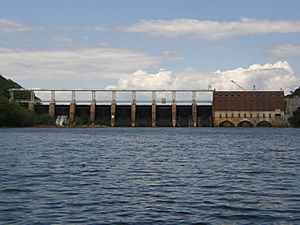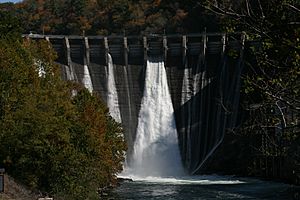Alcoa Power Generating facts for kids
Alcoa Power Generating, Inc. was a company that helped make electricity. It was a part of Alcoa Inc., a big company known for making aluminum. Alcoa Power Generating, Inc. (APGI) had three main parts that worked together. These parts used the power of water to create hydroelectric power. They also managed large water areas called reservoirs, which helped with flood control, offered places for fun activities, and provided homes for wildlife.
Contents
The Yadkin Project: Powering Up North Carolina
The Yadkin Project was managed by APGI and covered a 38-mile part of the Yadkin River in North Carolina. It included four dams, powerhouses, and reservoirs. In February 2017, this project was sold to Cube Hydro Carolinas. The dams were the Narrows dam (built in 1917), the Falls dam (1919), the High Rock dam (1927), and the Tuckertown dam (1962). The Narrows dam is special because it's listed on the National Register of Historic Places.
A Look Back: How the Yadkin Project Started
The Yadkin River at a place called the Narrows was perfect for making power. In the late 1800s, an English mining expert named E.B.C. Hambley and a businessman from Pittsburgh named George I. Whitney saw this potential. They started building the Whitney Dam and a long canal, but their company went bankrupt in 1907. The canal is still there today!
In 1912, a French company bought the project. They planned to build a new dam and an aluminum plant, even planning a town called Badin for the workers. But World War I started, and many French engineers went home, stopping the project again.
Then, in 1915, the Aluminum Company of America (later called Alcoa) bought the property. They changed the plans for the dam and built a new powerhouse. A big flood in 1916 caused delays. When the Narrows Dam was finished in 1917, it was the world's tallest "overflow" dam at 185 feet high. The lake it created, Badin Lake, is very deep and covers a large area.
To make even more electricity, the company built Falls Dam in 1919 and High Rock Dam in 1927. High Rock Lake became the biggest lake on the Yadkin River. In 1929, the company changed its name to Alcoa. Later, in 1962, Alcoa built the Tuckertown Dam.
Alcoa stopped making aluminum at the Badin plant in 2002 and closed the electrode plant in 2007. However, the dams kept making electricity, which Alcoa sold. In 2016, Cube Hydro Carolinas bought the power plants on the Yadkin River from APGI. The sale was finalized in February 2017. In 2019, another company, Ontario Power Generation, bought Cube Hydro.
Keeping the Environment Safe
For many years, Alcoa used to get rid of a waste product called "spent potlining." In 1980, the EPA said this waste was dangerous. Alcoa tried to fix the problem, but some studies, like one from Duke University, found that waste from the old plant was still affecting the water and soil nearby. They found that polluted underground water had reached a nearby creek. More studies were needed to check other areas. Duke University suggested digging up and removing the dangerous waste.
New Life for the Old Site
In 2011, Alcoa announced it would spend $10 million to get the Badin Works site ready for new businesses. They tore down old buildings and made improvements. A company called Electronic Recyclers International, which recycles things like computers and cell phones, planned to open a large recycling center there. Even after selling its power plants in 2016, APGI continued to help new businesses come to the Badin Business Park.
Getting a New License for the Dams
To operate the dams, Alcoa needed a special federal license, which lasts for 50 years. The old license was given in 1958. In 2002, APGI started the process to get a new license. They held many public meetings and worked with different groups, including government agencies and environmental organizations. They also did many studies on how the project affected the environment, local economy, and recreation.
However, there were disagreements. Some local leaders and groups were worried about environmental cleanup and wanted a different company to run the dams to create more jobs for North Carolina. North Carolina governors also expressed concerns.
There was a big debate about whether the state should take over the dams. A TV documentary about Alcoa's environmental history in North Carolina was even shown in the state Senate.
Legal battles also took place over who owned the land under the lakes. North Carolina claimed it owned the land, but Alcoa said it had bought the land. In 2015, a judge ruled that the Yadkin River was not "navigable" when the U.S. became independent, meaning the state didn't automatically own the riverbed. In 2017, a higher court agreed, and in 2018, the U.S. Supreme Court refused to hear an appeal, confirming Alcoa owned the riverbed.
In September 2016, Alcoa received a new license to operate the dams until 2055. This license included rules about keeping a minimum water level in High Rock Lake and having a swimming beach. These rules now apply to Cube Hydro Carolinas, the company that bought the dams.
As part of the new license, a large amount of land (about 9,000 acres) around the Yadkin River was sold to the N.C. Wildlife Resources Commission and the LandTrust for Central North Carolina. This land is used for wildlife and outdoor activities, ensuring it stays protected.
Water Quality Rules
Another important part of getting the license was a "water quality certificate." This certificate makes sure that the dam operations meet state standards for water quality, especially for "dissolved oxygen" levels in the water released from the dams. There were disagreements and legal challenges about this certificate. At one point, the state took back Alcoa's certificate because of concerns about information Alcoa had provided.
After more legal discussions, in 2015, a judge ruled that the state had wrongly denied the certificate. In October 2015, the state approved the certificate, but with a condition that Alcoa provide $48 million for improvements.
The Tapoco Project: Power in the Mountains
The Tapoco Project included four dams in North Carolina and Tennessee, on the Little Tennessee and Cheoah rivers. These dams provided power to Alcoa's aluminum plant in Alcoa, Tennessee. The four dams are Calderwood, Cheoah, Chilhowee, and Santeetlah. Together, they could produce a lot of electricity.
Around 1910, Alcoa started buying companies to build these hydroelectric power plants. The name "Tapoco" came from the first two letters of "Tallassee Power Company," one of the companies Alcoa bought. The aluminum plant started working in 1913.
During World War I and World War II, there was a high demand for aluminum. The Cheoah Dam started operating in 1919, and the Santeetlah Dam began in 1926. Calderwood Dam was finished in 1930, and Chilhowee Dam was the last, completed in 1957.
Alcoa received a federal license for these dams in 1955. They had to resolve some issues, like flooding in the Great Smoky Mountains National Park, before getting a new license. In 2004, a law helped fix this by trading land, giving some land to the park and protecting other Alcoa land. A new 40-year license was given in 2005.
Alcoa stopped making aluminum at its Tennessee plant in 2009. In 2012, the company sold its dams to Brookfield Renewable Energy Partners of Canada for $600 million. The Tapoco-APGI operations then became Brookfield Smoky Mountain Hydropower.
A fun fact: The Cheoah Dam was used in the movie The Fugitive, where Harrison Ford's character jumps from it!
The Long Sault Project: Power from the St. Lawrence
Alcoa started its Massena operation in Massena, New York, in 1902 because there was a lot of hydroelectric power available there. This plant has been making aluminum for a very long time. The power comes from the New York Power Authority (NYPA). Alcoa's Long Sault Division owns and operates five power lines that connect NYPA to Hydro-Québec, which originally connected to the St. Lawrence River project.



